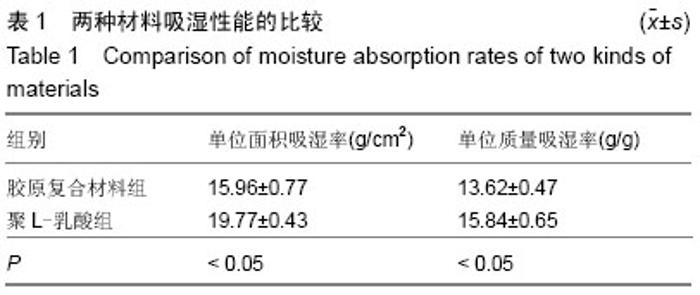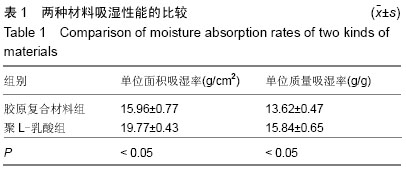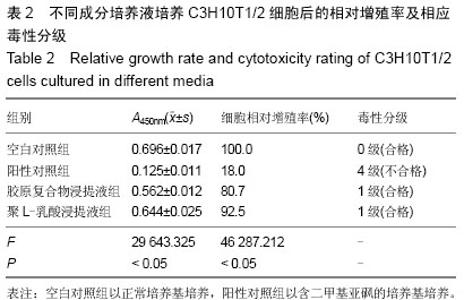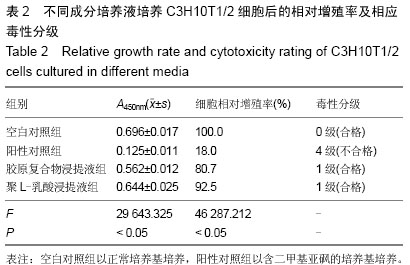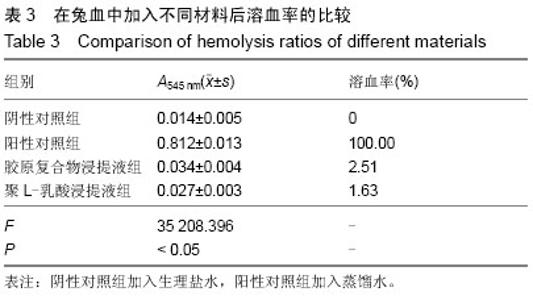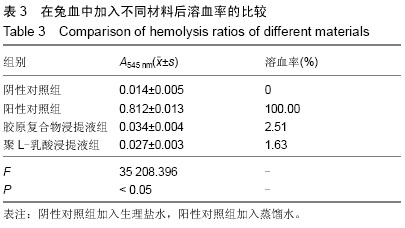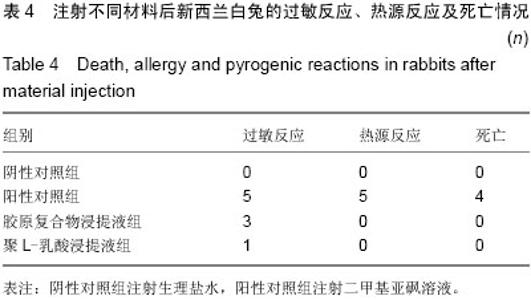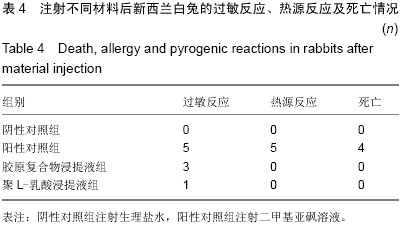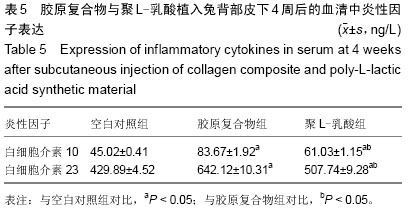Chinese Journal of Tissue Engineering Research ›› 2015, Vol. 19 ›› Issue (34): 5480-5484.doi: 10.3969/j.issn.2095-4344.2015.34.014
Previous Articles Next Articles
Biocompatibility of poly-L-lactic acid, a new synthetic material for skin burn
Deng Li-huan
- Department of Burn Surgery, Third People’s Hospital of Huizhou, Huizhou 516002, Guangdong Province, China
-
Online:2015-08-20Published:2015-08-20 -
About author:Deng Li-huan, Master, Department of Burn Surgery, Third People’s Hospital of Huizhou, Huizhou 516002, Guangdong Province, China
CLC Number:
Cite this article
Deng Li-huan. Biocompatibility of poly-L-lactic acid, a new synthetic material for skin burn[J]. Chinese Journal of Tissue Engineering Research, 2015, 19(34): 5480-5484.
share this article
| [1] Li J,Hong J,Zheng Q, et al.Repair of rat cranial bone defects with nHAC/PLLA and BMP-2-related peptide or rhBMP-2.J Orthop Res.2011;29(11):1745-1752. [2] Yuan Y,Jin X,Fan Z,et al.In vivo degradation of copolymers prepared from L-lactide, 1,3-trimethylene carbonate and glycolide as coronary stent materials. J Mater Sci Mater Med. 2015;26(3):139. [3] Pauck RG,Reddy BD.Computational analysis of the radial mechanical performance of PLLA coronary artery stents.Med Eng Phys.2015;37(1):7-12. [4] Busch R,Strohbach A,Rethfeldt S,et al.New stent surface materials: the impact of polymer-dependent interactions of human endothelial cells, smooth muscle cells, and platelets.Acta Biomater.2014;10(2):688-700. [5] Inoue M,Sasaki M,Katada Y,et al.Poly-(L-lactic acid) and citric acid-crosslinked gelatin composite matrices as a drug-eluting stent coating material with endothelialization, antithrombogenic, and drug release properties.J Biomed Mater Res A.2013;101(7): 2049-2057. [6] Flege C,Vogt F,Höges S,et al.Development and characterization of a coronary polylactic acid stent prototype generated by selective laser melting.J Mater Sci Mater Med.2013;24(1): 241-255. [7] Kim HI,Ishihara K,Lee S,et al. Tissue response to poly (L-lactic acid)-based blend with phospholipid polymer for biodegradable cardiovascular stents.Biomaterials. 2011;32(9):2241-2247. [8] Bruining N,de Winter S,Roelandt JR,et al.Monitoring in vivo absorption of a drug-eluting bioabsorbable stent with intravascular ultrasound-derived parameters a feasibility study.JACC Cardiovasc Interv.2010;3(4):449-456. [9] Lewis RA.Ab interno approach to the subconjunctival space using a collagen glaucoma stent. J Cataract Refract Surg. 2014;40(8):1301-1306. [10] Zhao N,Workman B,Zhu D.Endothelialization of novel magnesium-rare earth alloys with fluoride and collagen coating. Int J Mol Sci.2014;15(4):5263-5276. [11] Li J,Zhang K,Chen H,et al.A novel coating of type IV collagen and hyaluronic acid on stent material-titanium for promoting smooth muscle cell contractile phenotype. Mater Sci Eng C Mater Biol Appl.2014;38:235-243. [12] Soltysiak P,Höllwarth ME,Saxena AK.Comparison of suturing techniques in the formation of collagen scaffold tubes for composite tubular organ tissue engineering. Biomed Mater Eng.2010;20(1):1-11. [13] Martínez de Arenaza I,Obarzanek-Fojt M,Sarasua JR,et al. Pyrene-end-functionalized poly(L-lactide) as an efficient carbon nanotube dispersing agent in poly(L-lactide): mechanical performance and biocompatibility study. Biomed Mater. 2015; 10(4):045003. [14] Cai Q,Shi Y,Shan D,et al.Osteogenic differentiation of MC3T3-E1 cells on poly (l-lactide)/Fe3O4 nanofibers with static magnetic field exposure. Mater Sci Eng C Mater Biol Appl.2015; 55:166-173. [15] Yang DZ,Chen AZ,Wang SB,et al.Preparation of poly(L-lactic acid) nanofiber scaffolds with a rough surface by phase inversion using supercritical carbon dioxide .Biomed Mater.2015; 10(3):035015. [16] Hu Y,Darcos V,Monge S,et al. Thermo-responsive drug release from self-assembled micelles of brush-like PLA/PEG analogues block copolymers.Int J Pharm.2015;491(1-2): 152-161. [17] Yang Y,Wu J,Jin G,et al.Research of osteoblastic induced rat bone marrow mesenchymal stem cells cultured on β-TCP/PLLA porous scaffold. Int J Clin Exp Med. 2015;8(3):3202-3209. [18] Di Bonito P,Petrone L,Casini G,et al.Amino-functionalized poly(l-lactide) lamellar single crystals as a valuable substrate for delivery of HPV16-E7 tumor antigen in vaccine development.Int J Nanomedicine.2015;10:3447-3458. [19] Yu Y,Lü X,Ding F. microRNA regulatory mechanism by which PLLA aligned nanofibers influence PC12 cell differentiation.J Neural Eng.2015;12(4):046010. [20] Kowalski W,Dammer M,Bakczewitz F,et al.In-situ investigation of stress conditions during expansion of bare metal stents and PLLA-coated stents using the XRD sin(2)ψ-technique.J Mech Behav Biomed Mater.2015; 49:23-29. [21] Lin JH,Chen CK,Wen SP,et al.Poly-L-lactide/sodium alginate/chitosan microsphere hybrid scaffolds made with braiding manufacture and adhesion technique: Solution to the incongruence between porosity and compressive strength. Mater Sci Eng C Mater Biol Appl.2015;52:111-120. [22] Pan P,Han L,Bao J,et al.Competitive Stereocomplexation, Homocrystallization, and Polymorphic Crystalline Transition in Poly(l-lactic acid)/Poly(d-lactic acid) Racemic Blends: Molecular Weight Effects.J Phys Chem B.2015;119(21):6462-6470. [23] Mashhadikhan M,Soleimani M,Parivar K,et al. ADSCs on PLLA/PCL Hybrid Nanoscaffold and Gelatin Modification: Cytocompatibility and Mechanical Properties. Avicenna J Med Biotechnol. 2015;7(1):32-38. [24] Liu M,Huang G,Cong Y,et al.The preparation and characterization of micelles from poly(γ-glutamic acid)-graft- poly(L-lactide) and the cellular uptake thereof. J Mater Sci Mater Med.2015;26(5):187. [25] Wach RA,Adamus A,Kowalska-Ludwicka K,et al.In vivo evaluation of nerve guidance channels of PTMC/PLLA porous biomaterial.Arch Med Sci.2015;11(1):210-219. [26] Zhang Z,Lv Q,Gao X,et al.pH-Responsive Poly(ethylene glycol)/Poly(L-lactide) Supramolecular Micelles Based on Host-Guest Interaction.ACS Appl Mater Interfaces. 2015 ; 7(16): 8404-8411. [27] Lizundia E,Vilas JL,León LM.Crystallization, structural relaxation and thermal degradation in Poly (L-lactide)/cellulose nanocrystal renewable nanocomposites. Carbohydr Polym.2015;123: 256-265. [28] Frydrych M,Román S,MacNeil S,et al.Biomimetic poly(glycerol sebacate)/poly(l-lactic acid) blend scaffolds for adipose tissue engineering. Acta Biomater.2015;18:40-49. [29] Uchida S,Utsunomiya H,Taketa T,et al.Arthroscopic fragment fixation using hydroxyapatite/poly-L-lactate Acid thread pins for treating elbow osteochondritis dissecans.Am J Sports Med. 2015;43(5):1057-1065. [30] Stein P,Vitavska O,Kind P,et al.The biological basis for poly-L-lactic acid-induced augmentation.J Dermatol Sci.2015; 78(1):26-33. |
| [1] | Shen Jinbo, Zhang Lin. Micro-injury of the Achilles tendon caused by acute exhaustive exercise in rats: ultrastructural changes and mechanism [J]. Chinese Journal of Tissue Engineering Research, 2021, 25(8): 1190-1195. |
| [2] | Liang Xueqi, Guo Lijiao, Chen Hejie, Wu Jie, Sun Yaqi, Xing Zhikun, Zou Hailiang, Chen Xueling, Wu Xiangwei. Alveolar echinococcosis protoscolices inhibits the differentiation of bone marrow mesenchymal stem cells into fibroblasts [J]. Chinese Journal of Tissue Engineering Research, 2021, 25(7): 996-1001. |
| [3] | Duan Liyun, Cao Xiaocang. Human placenta mesenchymal stem cells-derived extracellular vesicles regulate collagen deposition in intestinal mucosa of mice with colitis [J]. Chinese Journal of Tissue Engineering Research, 2021, 25(7): 1026-1031. |
| [4] | Liu Liu, Zhou Qingzhu, Gong Zhuo, Liu Boyan, Yang Bin, Zhao Xian. Characteristics and manufacturing techniques of collagen/inorganic materials for constructing tissue-engineered bone [J]. Chinese Journal of Tissue Engineering Research, 2021, 25(4): 607-613. |
| [5] | Xu Xiaoming, Chen Yan, Song Qian, Yuan Lu, Gu Jiaming, Zhang Lijuan, Geng Jie, Dong Jian. Human placenta derived mesenchymal stem cell gel promotes the healing of radiation skin damage in SD rats [J]. Chinese Journal of Tissue Engineering Research, 2021, 25(25): 3976-3980. |
| [6] | Wang Hao, Chen Mingxue, Li Junkang, Luo Xujiang, Peng Liqing, Li Huo, Huang Bo, Tian Guangzhao, Liu Shuyun, Sui Xiang, Huang Jingxiang, Guo Quanyi, Lu Xiaobo. Decellularized porcine skin matrix for tissue-engineered meniscus scaffold [J]. Chinese Journal of Tissue Engineering Research, 2021, 25(22): 3473-3478. |
| [7] | Chen Lei, Zheng Rui, Jie Yongsheng, Qi Hui, Sun Lei, Shu Xiong. In vitro evaluation of adipose-derived stromal vascular fraction combined with osteochondral integrated scaffold [J]. Chinese Journal of Tissue Engineering Research, 2021, 25(22): 3487-3492. |
| [8] | Yang Li, Li Xueli, Song Jinghui, Yu Huiqian, Wang Weixia. Effect of cryptotanshinone on hypertrophic scar of rabbit ear and its related mechanism [J]. Chinese Journal of Tissue Engineering Research, 2021, 25(20): 3150-3155. |
| [9] | Liu Zhendong, Wang Rui, Li Xiaolei, Wang Jingcheng. Review of interferon alpha-2b inhibiting scar formation [J]. Chinese Journal of Tissue Engineering Research, 2021, 25(2): 317-321. |
| [10] | Chen Siyu, Li Yannan, Xie Liying, Liu Siqi, Fan Yurong, Fang Changxing, Zhang Xin, Quan Jiayu, Zuo Lin. Thermosensitive chitosan-collagen composite hydrogel loaded with basic fibroblast growth factor retards ventricular remodeling after myocardial infarction in mice [J]. Chinese Journal of Tissue Engineering Research, 2021, 25(16): 2472-2478. |
| [11] | Chen Liang, Meng Shu, Cheng Guoping, Ding Yi . Effects of fish scale collagen membrane on adhesion, proliferation and osteogenic differentiation of rat bone marrow mesenchymal stem cells [J]. Chinese Journal of Tissue Engineering Research, 2021, 25(16): 2494-2499. |
| [12] | Zhang Hui, Wang Shaohua, Wang Qian, Wang Hui, Gan Hongquan, Cui Yishuang, Li Qijia, Wang Zhiqiang. Porous tantalum coated with RGD polypeptide can activate the integrin/focal adhesion kinase signaling pathway of MG63 cells [J]. Chinese Journal of Tissue Engineering Research, 2021, 25(16): 2535-2540. |
| [13] | Li Shao, Liang Yongkang, Gao Yi, Peng Qing. Establishment and functional in vitro characteristics of three-dimensional collagen HepaRG microsphere [J]. Chinese Journal of Tissue Engineering Research, 2021, 25(16): 2541-2547. |
| [14] | Liu Yunyi, Wang Bo, Wang Lin. Effects of post-exercise gastrocnemius needling on Achilles tendon degeneration in obese rats [J]. Chinese Journal of Tissue Engineering Research, 2021, 25(14): 2211-2218. |
| [15] | Liu Zhigang, Guo Qinggong, Chen Jingtao. Effect of Capparis spinosa total alkaloid on proliferation and apoptosis of nucleus pulposus cells in an intervertebral disc degeneration rat model [J]. Chinese Journal of Tissue Engineering Research, 2021, 25(11): 1699-1704. |
| Viewed | ||||||
|
Full text |
|
|||||
|
Abstract |
|
|||||
